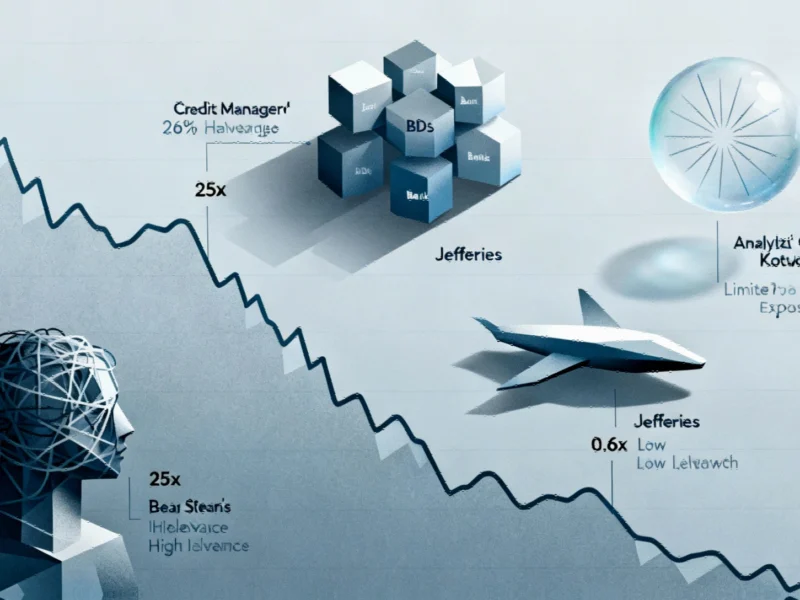Market Tremors Extend Beyond Banking Sector
The global financial landscape is experiencing significant turbulence as banking sector concerns trigger widespread market reactions. What began as isolated issues at regional banks has rapidly evolved into a broader market event, with the VIX volatility index surging 32% to reach levels not seen since the April tariff disruptions. The selling pressure has extended across multiple asset classes, indicating deeper systemic concerns than initially anticipated.
According to market analysts at ING, the current situation represents a genuine “contagion” effect that has spread to Nasdaq 100 futures, which dropped 1.4% in early trading. The pattern mirrors concerns from the 2023 banking crisis but with distinct characteristics that have traders particularly concerned about credit market stability.
Regional Bank Exposure Reveals Systemic Vulnerabilities
The catalyst emerged from unexpected quarters—Zions Bancorporation and Western Alliance Bank, two institutions previously unknown to most investors outside their regional footprints. Their disclosure of $50-60 million in potentially fraudulent bad loans triggered a cascade effect across the banking sector. The resulting selloff erased approximately $100 billion in market capitalization from 74 American bank stocks, while the S&P Regional Banks Select Industry Index suffered its worst decline since April.
Market participants are drawing connections to recent banking sector developments that suggest broader underlying weaknesses. Peter Schaffrik of RBC noted in client communications that the rapid deterioration in regional bank stocks reflects persistent market sensitivity to credit quality concerns, a legacy of the 2023 SVB collapse that continues to influence investor psychology.
Private Credit Market Under Microscope
Investor anxiety has been compounded by the First Brands scandal, where the automotive parts supplier secured over $10 billion in private credit market loans before declaring bankruptcy. This case has raised fundamental questions about due diligence processes in the rapidly expanding private credit ecosystem, despite assurances from major institutions about their risk management practices.
The situation highlights how emerging financial technologies and traditional banking are increasingly interconnected in ways that can amplify systemic risks. Francesco Pesole of ING observed that “the contagion to other risk assets shows not only that markets are still sensitive to regional bank concerns, but potentially to the broader credit market.”
Global Impact and Currency Implications
The ripple effects have extended beyond U.S. markets, with European indices including the Stoxx 600 and FTSE 100 both losing more than a full percentage point immediately after opening. The dollar, as measured by the DXY index, has declined 0.73% against foreign currencies over the past five days, suggesting that global confidence in U.S. financial stability may be wavering.
Pesole further noted that while risks appear more isolated than in 2023, they could feed into a narrative that “the U.S. business environment and credit quality are in a poorer state than what data suggests.” This perspective is particularly relevant given how technological innovations are reshaping business fundamentals across sectors.
Flight to Safety and Credit Market Stress
Deutsche Bank analysts led by Peter Sidorov reported that the selling has moved into high-yield credit as investors seek refuge in U.S. government bonds. “Other risk assets also struggled, with US HY credit spreads +10bps wider. Treasuries rallied with the 2yr yield dropping -7.3bps to a 3-year low of 3.42%,” Sidorov told clients.
The market movement reflects growing concerns about credit quality that extend beyond immediate banking issues. As Andrew Milgram of Marblegate Asset Management told the Financial Times, credit market participants have maintained “a grudging recognition that there was and is a series of credit problems that could be substantial and could be dangerous to the overall economy.” These concerns are particularly relevant in the context of evolving technological landscapes that are transforming risk assessment methodologies.
Liquidity Pressures Emerge
Adding to concerns, banks have unexpectedly utilized the Federal Reserve’s repo facility for a second consecutive day, despite this typically being end-of-period behavior. This suggests that cash reserve pressures at some institutions may be more acute than publicly acknowledged, raising questions about interbank liquidity conditions.
The situation underscores the importance of robust security frameworks in financial systems as technological complexity increases. Market participants will be closely monitoring upcoming regional bank earnings for any signs of further deterioration, with particular attention to credit quality metrics and liquidity positions.
As financial institutions navigate these challenges, the role of technology leadership in maintaining operational resilience becomes increasingly critical. The current market stress test highlights how interconnected global financial markets remain vulnerable to credit quality concerns, regardless of their apparent isolation in specific sectors or institutions.
This article aggregates information from publicly available sources. All trademarks and copyrights belong to their respective owners.



